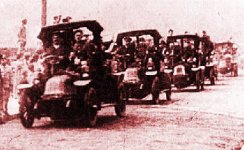Pierre-
Those look great. Some more info on animals at war:
Hundreds of thousands of dogs were also used during the First and Second World Wars. They were used by the Red Cross and wore a harness on their body with a loincloth that had the Red Cross symbol. They carried emergency bandaging and were trained to go out over open ground to be of aid to wounded soldiers. Once they reached their target, they were taught to sit and bark to alert the stretcher bearers and field ambulance drivers; however sometimes, unfortunately, the Germans were alerted first. Dogs were also used by all sides for night raids in trenches; the Italians used sheep dogs for carrying hand grenades in a pack saddle; there were dogs used by the signal corps for running messages; and ‘suicide dogs’ were used whereby they had a harness with an explosive and trigger mechanism on their backs and they were trained to run over open ground and under a tank or a truck.
Soldiers were only in the front line trenches for a couple of days on the western front and then they were sent back to the remedial lines to stop them going mad with the noise, boredom or terrible conditions. Looming was dysentery, trench fever, septicemia, and trench feet. There were also rats living off the corpses so England sent across highly trained terriers called ‘rat dogs’ who were placed over the corpses to keep the rats off. Before the rat dogs there had been orders to dig graves in the walls of the trenches but when the rains came the bodies washed out and hence the dogs were put into service.
Pigeons were used for communication. The Germans trained hawks to kill the pigeons in flight as they went over their trench lines so that they could get the messages being carried; the British in turn trained falcons to kill the hawks. Birds were largely demobilised after the First World War with the introduction of newer planes and newer forms of wireless communication.



